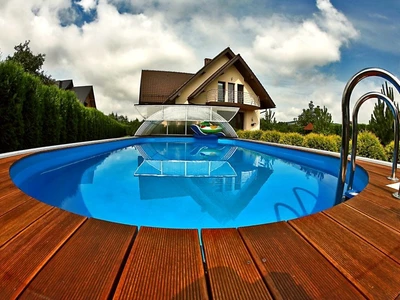How to keep your pool water clean?

Having a swimming pool is a dream come true, but it also marks the beginning of taking care of water quality so it always remains crystal clear and lagoon-like.
Don’t worry — maintaining and cleaning pool water does take some time and requires some knowledge, but it’s not that difficult. It’s easy to learn, and we’re here to provide you with some useful tips.
Get to know your pool and its components
First and foremost, you should be familiar with your pool — that is, know what components it consists of. Start by reading the documentation provided with your pool along with its maintenance manual — these should be provided by any reputable manufacturer or supplier. For better understanding, you can also check out various online videos, of which there are plenty available today. Knowing the basic components of your pool and its technical background will help you keep the pool in great condition, including the quality of the water. It will also make it easier and faster to resolve any issues that may arise.
Take care of your pool
To keep your pool water clear and clean and to enjoy the best swimming experience at all times, it’s important to focus especially on the following parts of the pool:
the skimmer and filtration system
the interior walls and floor of the pool
the water source and its composition
the pool chemicals used
In the following parts of this article, we’ll cover a few specific actions you shouldn’t forget to carry out regularly.
Monitor the pH level of your pool water
First, regularly check the pH value of your pool water. The goal is to maintain a pH between 7.0 and 7.4. If the measured value goes outside this range, you should use special agents to either raise or lower the pH. Check the pH at least once a week (we recommend doing this even during the winter months when the pool is winterized). pH test kits and adjustment chemicals can be purchased at any pool supply store.
Clean the skimmer basket
The skimmer is a technical device that gradually draws water from the pool’s surface and directs it to the filtration system where it’s cleaned. Part of the skimmer is a coarse debris strainer — the so-called skimmer basket — which prevents larger mechanical debris (such as twigs, leaves, or other natural debris, as well as foreign objects like paper or plastic cups) from entering the filtration system. It’s essential to keep the skimmer basket clean at all times, as debris that accumulates in the basket can otherwise clog the filtration system.
Remove algae and debris from the pool walls and floor
If you notice algae growing on the walls or floor of the pool, treat the water immediately with a product specifically designed to eliminate algae. Once the algae loosen, use a special pool vacuum to remove them from the pool. If you notice other coarse debris on the pool walls or floor, use a suitable pool brush to remove them.
Ensure proper water circulation
Flowing water enhances cleaning efficiency and slows down the buildup of contaminants. Therefore, maintain adequate water circulation in your pool to keep the water clearer and ready for swimming. The shape of your pool already influences water circulation (rounded shapes are better for optimal water flow, while rectangular or angular pools often struggle with circulation in the corners). Aside from the shape, you can influence circulation by running the pump and filtration system as often as possible. Your pool pump should ideally run for 10 to 12 hours a day (ideally continuously). Don’t forget to regularly clean your filtration system as well.
Maintain the optimal water level
For optimal function and performance of the filtration system and pump, the water level must be aligned with the midpoint of the skimmer. If the water level is too low, the pump may run dry and burn out. If the skimmer door, which draws in water along with debris, is completely submerged, the skimmer won’t function correctly.
Track and plan your maintenance
Don’t rely on memory alone to keep track of all the maintenance activities. Keep records of completed maintenance and note the concentration of any chemicals used. This will help you maintain an overview of your pool, and these records can help you determine what works best for your water quality over time. For larger and more complex maintenance tasks, plan their timing in advance. And don’t forget — you don’t have to do it alone. Simply ask other household members to help out.
Be attentive and don’t overlook issues
And one final general tip: be observant of your pool. Check the water quality visually and with test tools (like pH meters), and don’t underestimate anything. Address any potential problems immediately — don’t wait hours or days.
We wish you joyful swimming and plenty of fun in your pool.